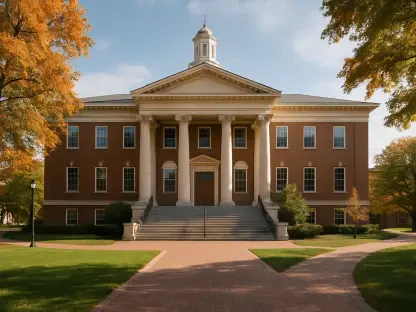Setting the Stage for a Higher Education Dilemma
The landscape of American higher education is facing a seismic shift with the recent introduction of a $100,000 fee for new H-1B visa petitions, a policy that has sent shockwaves through academic institutions nationwide, threatening to disrupt their ability to attract top international talent. This dramatic escalation from the previous fee range of $2,000 to $5,000 poses a significant challenge to colleges and universities, which have long relied on such talent as a cornerstone of innovation and academic excellence in the U.S. With thousands of faculty, researchers, and scholars currently contributing to campus life under this visa program, the financial and operational hurdles raised by this change spark critical questions about the future of global collaboration in education. This report delves into the intricacies of the policy, its implications for institutions of all sizes, and the strategies emerging to navigate this unprecedented challenge.
Understanding the H-1B Visa Program and Its Role in Higher Education
The H-1B visa program has long served as a vital mechanism for U.S. colleges and universities to recruit skilled international professionals, including faculty, researchers, and scholars who bring unique expertise to academic environments. This program allows institutions to fill specialized roles that often lack sufficient domestic candidates, thereby enriching the intellectual fabric of campuses across the country. Without such talent, many advanced research initiatives and niche academic programs would struggle to maintain their current standards of excellence.
Prominent institutions like Stanford University, the University of Michigan, and Columbia University exemplify this reliance, with each employing over 200 H-1B visa holders as of the latest data in 2025. These numbers reflect not just a staffing strategy but a commitment to fostering a diverse and globally competitive academic community. The presence of international talent is particularly pronounced in fields like science, technology, engineering, and mathematics, where specialized knowledge drives cutting-edge discoveries.
Beyond individual hires, the H-1B program underpins broader contributions to research, innovation, and educational offerings within the higher education sector. International scholars often lead groundbreaking studies, mentor students from varied backgrounds, and enhance course diversity with global perspectives. Their work directly supports the U.S. position as a leader in academic advancement, making the program’s accessibility a matter of national significance.
The New $100,000 H-1B Visa Fee: Policy Overview and Scope
Key Details of the Fee Structure
On September 19, a transformative policy shift was announced, raising the fee for new H-1B visa petitions from a modest $2,000–$5,000 range to an unprecedented $100,000. This substantial increase targets employers sponsoring foreign workers entering the U.S. for the first time under this visa category. As clarified by U.S. Citizenship and Immigration Services (USCIS), the fee applies solely to new petitions for individuals outside the country and does not impact current H-1B holders or those seeking status changes domestically.
Significant confusion initially surrounded the policy’s specifics, with early speculation suggesting an annual fee rather than a one-time charge. Official statements have since confirmed the latter, yet ambiguities persist regarding implementation timelines and procedural details. Such uncertainty complicates planning for institutions already grappling with the policy’s financial weight.
Immediate Reactions and Sector Concerns
Higher education leaders and advocacy groups, including the Presidents’ Alliance on Higher Education and Immigration, have voiced immediate alarm over the fee’s potential to deter global talent from joining U.S. campuses. This barrier could diminish the pool of qualified candidates for critical roles, directly affecting academic quality and institutional reputation. Many fear a ripple effect on students who rely on specialized courses and mentorship from international faculty.
Concerns also center on the broader implications for research and innovation, as the inability to hire essential personnel may stall projects vital to national interests. Leaders argue that while the policy aims to protect American workers, it risks undermining the very sectors—education and scientific advancement—that bolster economic and intellectual growth. This tension between policy intent and practical outcomes remains a focal point of debate.
Financial and Operational Challenges for Colleges
The imposition of a $100,000 fee per new H-1B visa petition places an immense financial burden on higher education institutions, regardless of their size or resources. Small colleges with constrained budgets face the stark reality of being unable to afford such costs, potentially excluding them from accessing international expertise altogether. Even for larger universities, redirecting substantial funds toward visa fees means diverting money from other priorities like student scholarships or facility upgrades.
Operationally, the policy threatens to disrupt campus functions in tangible ways, from delays in research initiatives to reduced course offerings due to unfilled faculty positions. Staffing shortages could become commonplace as institutions hesitate to sponsor new hires under the prohibitive fee structure. This scenario risks diminishing the academic experience for students and slowing progress on projects with real-world impact.
Expert analysis suggests that these challenges may force a reevaluation of hiring practices, with some colleges potentially scaling back on international recruitment or seeking less costly alternatives. Long-term strategies might include restructuring budgets or prioritizing domestic candidates, though such shifts could compromise the diversity and quality of academic programs. The strain of balancing these priorities underscores the depth of the policy’s impact on institutional planning.
Regulatory Uncertainties and Exemption Possibilities
The regulatory framework surrounding the new H-1B fee includes provisions for exemptions, described by USCIS as “extraordinarily rare” and contingent on national interest and security considerations. To qualify, an institution must demonstrate that a worker’s presence is critical, poses no risk, and that no American candidate can fulfill the role. Additionally, imposing the fee must be shown to significantly harm national interests, a high bar that remains poorly defined.
This lack of clear guidelines for exemptions leaves colleges in a state of uncertainty, unable to predict eligibility or navigate the application process with confidence. Many institutions find themselves in limbo, unsure whether their hires—often essential to medical research or technological innovation—will meet the stringent criteria. This ambiguity hampers effective decision-making at a time when clarity is most needed.
Advocacy efforts by organizations like the American Council on Education (ACE) have intensified, with calls for sector-wide exemptions to shield higher education from the fee’s effects. While nearly three dozen groups have petitioned for relief, the White House maintains a focus on protecting American workers, showing little inclination to grant broad exceptions. This standoff between policy goals and academic needs continues to shape the conversation around potential regulatory adjustments.
Legal Challenges and Future Policy Outlook
Legal opposition to the $100,000 fee has emerged swiftly, with coalitions representing higher education, healthcare, and other sectors filing lawsuits to challenge its legality. These actions, supported by entities like the U.S. Chamber of Commerce, argue that the policy represents an unlawful overreach of executive authority and inflicts severe damage on national interests. A ruling in favor of these plaintiffs could halt or modify the fee’s implementation.
The outcomes of these legal battles carry significant implications for the policy’s future, potentially offering relief to colleges or reinforcing the current barriers. While some hope for a complete reversal, others anticipate more limited adjustments that might ease the burden without fully dismantling the fee structure. The uncertainty of litigation adds another layer of complexity to institutional planning.
Looking ahead, the broader stance of the Trump administration on high-skilled immigration suggests a continued emphasis on restrictive measures, though acknowledgments of the value of such talent provide a sliver of optimism. Between 2025 and 2027, policy shifts could emerge through legislative action or executive reconsideration, depending on political and economic pressures. Colleges remain vigilant, preparing for various scenarios as the legal and policy landscape evolves.
Strategic Responses and Recommendations for Colleges
In response to the daunting fee, higher education institutions are advised to adopt proactive measures, such as preparing detailed exemption requests for critical hires. This process demands legal expertise to craft arguments that align with national interest criteria, a task requiring both time and resources. Early preparation can position colleges to make compelling cases for essential international talent.
Exploring alternative visa options, such as the O visa for individuals with extraordinary abilities, presents another pathway, though limitations exist. The high eligibility threshold of the O visa often excludes early-career professionals, restricting its applicability for many academic roles. Institutions must weigh these constraints against the urgent need to fill positions, often under tight timelines.
Engagement with policymakers at local and federal levels stands out as a crucial strategy for long-term change. By educating officials on the adverse effects of the fee, colleges can advocate for exemptions or policy reversals that align with economic and educational goals. This dual approach of tactical adaptation and persistent advocacy offers a balanced framework for navigating the current challenges while pushing for systemic reform.
Reflecting on a Pivotal Moment
Looking back, the introduction of the $100,000 H-1B visa fee marked a defining challenge for higher education, straining budgets, disrupting operations, and erecting barriers to global talent recruitment. The sector responded with a blend of immediate adjustments and determined advocacy, seeking to mitigate the policy’s impact through exemptions and legal challenges. As institutions adapted, the resilience of academic communities shone through despite the uncertainty that loomed over hiring practices.
Moving forward, colleges must prioritize collaboration with legal experts and advocacy groups to secure relief, whether through individual exemptions or broader policy changes. Building coalitions to amplify their voice in policy discussions emerged as a vital step, ensuring that the value of international talent was not overlooked. By maintaining this momentum, higher education could safeguard its role as a hub of innovation, even in the face of formidable obstacles.









